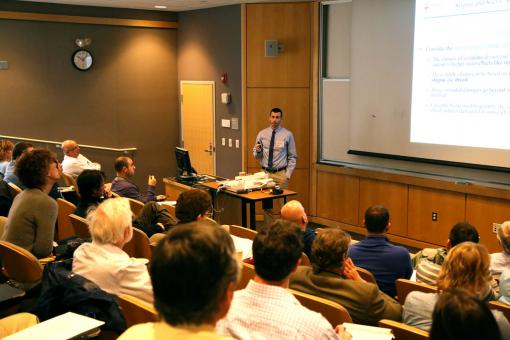
James Rice discussed how community interests and social issues need to be understood to appropriately communicate risk to the community. During his talk, he encouraged thoughtful discussion from the audience.
Credit: Jeff Brown/Brown University
The Brown University Superfund Research Program (SRP) partnered with the Northeast Waste Management Officials' Association (NEWMOA) to host a workshop on communicating risk to the public March 27 and 28. The audience of 150 registrants included state and EPA regulators and consultants typically involved in waste site cleanups.
At the workshop, representatives from Brown SRP and partners from other SRP centers and organizations offered their expertise on what to consider when communicating with the public and how to manage and deliver messages related to risk from hazardous substances. Brown SRP Research Translation Core (RTC) State Agencies Liaison Jim Rice, Ph.D., worked with NEWMOA Project Manager Jennifer Griffith to host the workshop.
"The council of state managers in the northeast region came to Griffith with the need for more training related to risk communication," said Rice. "Because of our ongoing partnership with Griffith, she suggested that Brown SRP could provide expertise on this topic. That led to us working together to develop an agenda and invite speakers relevant to those involved in waste site cleanups in the northeast."
What to Consider When Communicating Risk
Rice kicked off the talks with a presentation on the social, psychological, and economic considerations when communicating risk. He explained how different people may approach a topic in different ways and that perception of risk combines the hazard as well as the level of outrage surrounding the topic. His presentation was followed by Kim Boekelheide, Ph.D., the Brown SRP Center Director, who gave an overview of toxicology to help inform risk communication. He explained how numbers are calculated in toxicology testing and the need to communicate the uncertainty associated with toxicity tests in mice and other animals.
Laurie Rardin from the Dartmouth SRP Center talked about controlling and managing messages. When Dartmouth SRP published the paper , "Arsenic, organic foods, and brown rice syrup," they did not expect the level of attention it received from the public and the media. She described how they handled the situation and what they could have done to keep the message clear and simple. She also explained the need to set up a two-way dialogue to build trust within a community.
Learning from Others
rown SRP Community Engagement Core co-leader Robert Vanderslice presented challenges and lessons learned from his work at the Gorham Silver Site, a hazardous waste and vapor intrusion-impacted site in Rhode Island.
"Participants were really able to engage in discussion with Vanderslice. He got people laughing and the participants were able to connect and relate to his experiences," said Rice. "The registrants came from six states in the northeast and don't often get to hear from regulators in different states so they value this time to hear from others."
Partners from the Metcalf Institute and the Center for Public Environmental Oversight also gave talks on understanding today's news media and provided practical steps for delivering a message to a community. The workshop concluded with a presentation by Boston University SRP RTC leader Madeleine Scammell, Ph.D., who discussed the planning process for risk communication and how to move forward to identify goals, assess knowledge, and develop appropriate messages.
"We got a lot of positive feedback with several people requesting that we do a second part to the workshop, or offer it again as a two-day session," said Griffith. "Based on the feedback we received, participants felt that the speakers were very informative, clear, concise, and interesting. There were also comments that the workshop had a high degree of applicability to situations regulators encounter frequently, even daily."
- Courtesy of Sara Mishamandani/NIEHS; reprinted with permission